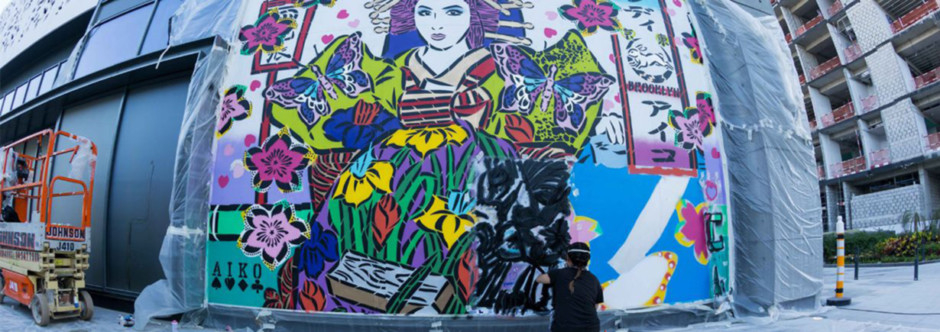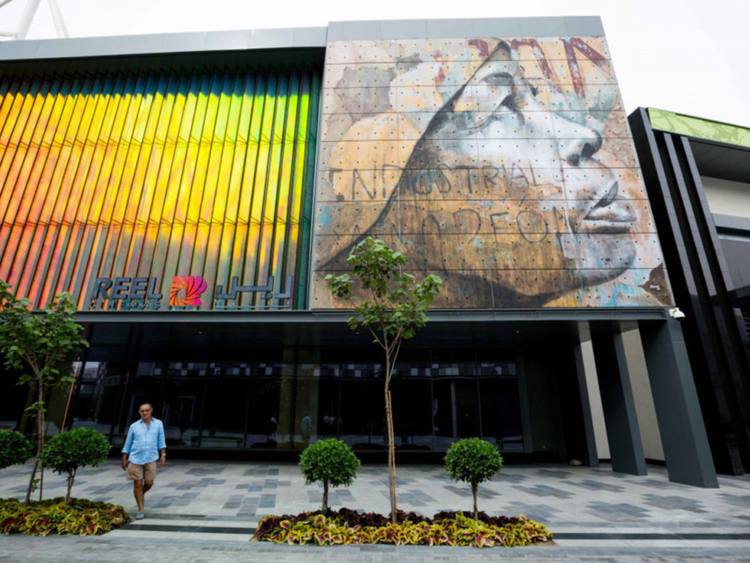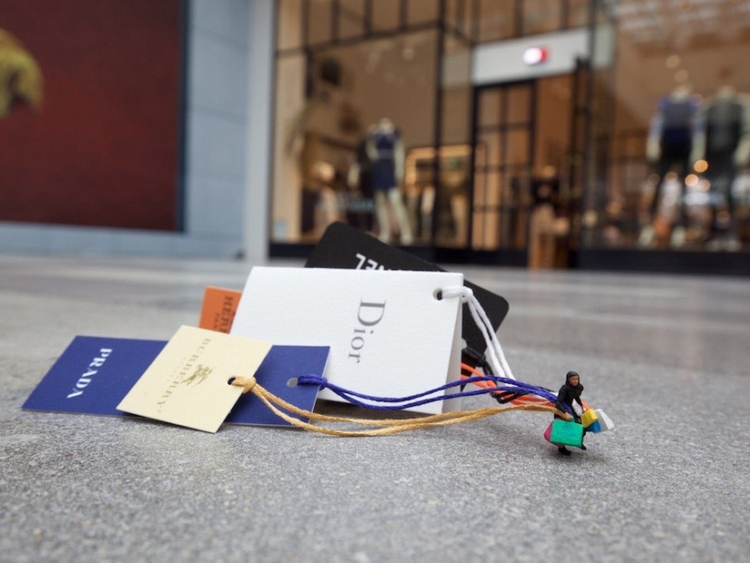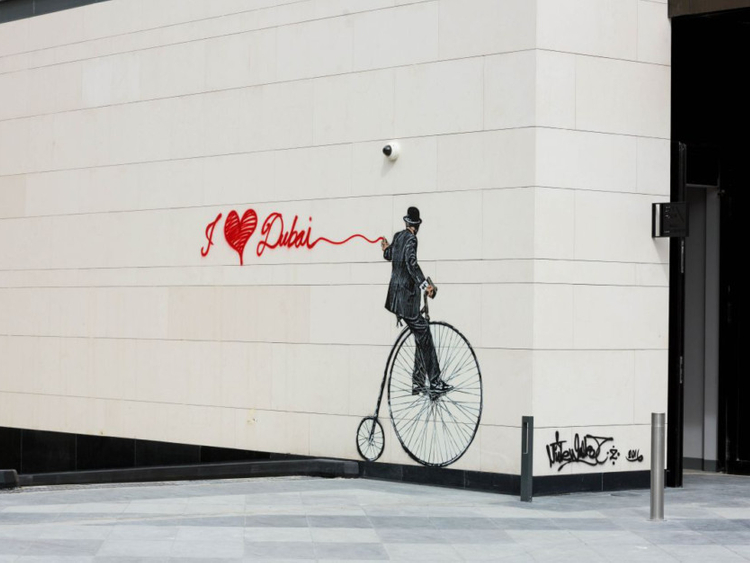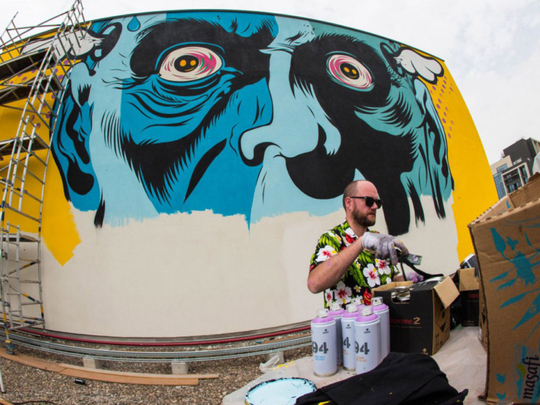
There are plenty of palm trees in Dubai, but when you spot some that are draped with colourful knitted yarn it sure makes you stop and smile. City Walk, the new urban living destination in Jumeirah, has many such delightful surprises for visitors, especially art lovers.
In fact, the entire development has been transformed into an open air museum of street art with works by 15 of the world’s top street artists adorning various walls and popping up in unexpected nooks and corners. The artists were invited by Dubai Walls, an initiative launched by Dubai-based holding company Meraas to bring quality street art to the Middle East.
D*Face, work in progress
The colourful palms, as well as some balconies and fire hydrants covered with knitting, are signature works by Magda Sayeg, the founder of the global yarn bombing movement.
The American artist is well-known for using knitted and crocheted yarn to transform mundane everyday objects into something colourful and fun. The other woman in the group is well-known New York-based Japanese artist Aiko, who has also filled her mural with an explosion of colour.
Blek le Rat, known as the godfather of stencil art, brings his signature black rodent to Dubai. The French artist’s playful rat can be seen pirouetting with a ballerina, singing along with a violinist and playing tug of war with a group of children, or just creeping around benches.
Ron English, a leading name in American street art and the creator of pop surrealism, has covered an entire wall with his pop version of Picasso’s “Guernica” featuring Mickey Mouse, Godzilla and other pop icons.
British stencil art pioneer Nick Walker’s alter ego, the suit and bowler hat wearing “vandal” is seen vandalising the walls with the slogan “I love Dubai”. Ben Eine, another leading figure of the British street art movement has claimed a spot high up on a wall for his signature typographical piece. British Prime Minister David Cameron carried a work by Walker as a gift to US President Barack Obama, and now Dubai has this gift direct from the artist. Other British artists who have contributed works include D*Face and Eelus.
Those who think that street art is only about using stencils and spray cans to quickly put your tag and scoot will be surprised to know that many of the works have been handpainted, such as Rone’s haunting portrait of a Cuban woman.
The Australian artist has carefully recreated a piece he originally did on a wall in Cuba, complete with the aged look of the wall and the name of a Cuban baseball team scribbled on it. Polish duo Etam Cru also did not use stencils or projection. They spent several days dangling from a crane in the hot sun to handpaint every detail of their six-storey high painting of a little girl, which is possibly the largest mural in the Middle East.
Rone's portrait of a Cuban woman
Belgian artist Roa’s depictions of animals indigenous to the UAE are also freehand drawings that speak about the impact of urbanisation on natural habitats, and Amsterdam-based The London Police have used marker pens to outline their futuristic landscape populated with smiley-faced robots that stretches across an entire wall. On the other end of the scale are Slinkachu’s miniature installations featuring desert and urban landscapes that evoke the feeling of being lost and alone in a big city.
American artist Beau Stanton’s Greco-Roman inspired anamorphic piece features a portrait that changes when viewed from another angle, and Iranian brothers Icy and Sot have created mirror image portraits on opposing walls, featuring a Middle Eastern woman with her headscarf symbolically morphed into a flock of flying birds.
City Walk, developed by Meraas, is the inaugural project by Dubai Walls, but the long term vision is to transform public spaces across the region into permanent street exhibitions that enhance the landscape and introduce people to the exciting and fast growing global street art movement.
Abdulla Al Habbai, Group Chairman of Meraas, says, “This initiative is a part of our commitment to the directives of His Highness Shaikh Mohammad Bin Rashid Al Maktoum, Vice-President and Prime Minister of the UAE and Ruler of Dubai, to transform Dubai into an open-air museum that dazzles the world and showcases the unique human experiences behind many of the emirate’s successes.
Nick Walker expresses his love for Dubai
The amazing works of street art by an acclaimed list of international artists will attract visual art lovers from across the globe and make the region even more attractive for tourists, stimulating the tourism sector and reinforcing Dubai’s position as a leading global art capital.”
Blek le Rat and Magda Sayeg spoke to Weekend Review about their romance with street art. Excerpts:
Blek le Rat:
How did you get interested in street art?
I was a 19-year-old architecture student when I visited New York in 1971, and I was amazed to see the graffiti on the walls. It was such a wonderful way for artists to express themselves and to display their creativity to everybody. It took me 10 years to digest what I had seen, before I started doing graffiti on the streets of Paris in 1981.
But I always believed that this movement will spread across the world, because there is nothing more important for an artist than to have their work seen by the public. I have given all my life to this movement and I am happy that this form of art is now respected and accepted as mainstream, because it makes art accessible to everybody. There are great artists working in the streets and their work is a gift to the public.
What is the idea behind your signature rat and the name Blek le Rat?
Rat is an anagram of art, which I am passionate about. I wanted to remind Parisians that their beautiful city is also shared by millions of rats living underground, so I anonymously stenciled lots of tiny rats on the walls of the city, which everybody started noticing and talking about. I took the name Blek le Rat from a comic I used to read as a child, which had nothing to do with rats.
How did you think of using stencils?
During a childhood trip to Italy, I was intrigued by vestiges of a portrait of Mussolini on a wall, and my father explained to me how the Fascist propaganda from the Second World War was made with stencils. Since I did not want to imitate American graffiti, I decided to start using stencils to do street art.
What is the story behind the three works you have done here?
The ballerina is about the grace and lightness of dance, and the violinist is inspired by the musicians I see performing on the streets. I have done these figures in many cities, but the tug of war piece is my special gift for Dubai. It shows children of different nationalities playing together and reflects the multicultural community of the city. It was incredible to be part of this project and I am leaving behind a part of myself in the city through these works.
Why do you use only black and white in your work?
There is already a lot of colour on the streets, so this palette stands out.
In your opinion what is good street art?
I feel street art should be on the same scale as the people, so that they can connect with it. It should touch people and be easy to understand. I avoid super-size works and conceptual or political themes that need time to digest or upset people. I choose simple themes because I just want to make people smile. And I believe that rather than looking for bigger or higher walls, I should surprise people by putting my work in unexpected places.
Magda Sayeg:
What attracted you to street art?
As someone who is not a trained artist, street art has given me a canvas to express myself and display my creativity in public. The work is ephemeral, but the fact that it resonates with enough people makes it worth the effort. I studied maths at university and had never imagined that I would be a street artist and that my work would grow into this worldwide yarn bombing movement. It just shows that hidden power can be found in the most unassuming places, and we all possess skills that are just waiting to be discovered.
Why did you choose yarn as a material for street art?
It started 10 years ago with a simple desire to put something warm, fuzzy and handmade on a grey, metallic door handle that I looked at every day. The positive reaction I got from people encouraged me to go out and cover other objects such as stop sign poles, railings and fire hydrants. It was a way of transforming them without changing their identity or functionality. I then moved on to bigger objects such as a bus, and now do a variety of large-scale installations. I think people like it because we all live in this fast-paced, digital world, but we still crave something that is relatable.
Do you always use bright colours?
I use bright colours to enhance the ordinary, and engage people with their environment. People become desensitised towards what they see every day, and changing it in this way makes them stop and look at it. It is a small thing, but it makes you stop and smell the roses and awakens your soul.
How was your experience of working in Dubai?
I have been here before and worked on a community project with Emirati women where we covered parts of the souq. But it was really exciting and satisfying to be part of a project that involves some of the greatest street artists of today. My father was from Lebanon, so having my work in this region means a lot to me.
Why do you like to cover the tiny fire hydrants?
I believe that being meaningful is not related to size, and often the smallest things can have the largest impact. I work on fire hydrants especially with children in mind, so that they can touch them and hug them.
Does being a woman make it more challenging to be a street artist?
It might have been if I was working with spray cans. But I work with yarn and needles. In the early days it was easy for me to work inconspicuously, and the police never bothered me because they thought a girl with knitting cannot cause much trouble.
Jyoti Kalsi is an arts-enthusiast based in Dubai.
For more information about the artists, and videos of the making of the works, visit www.dubaiwalls.com


